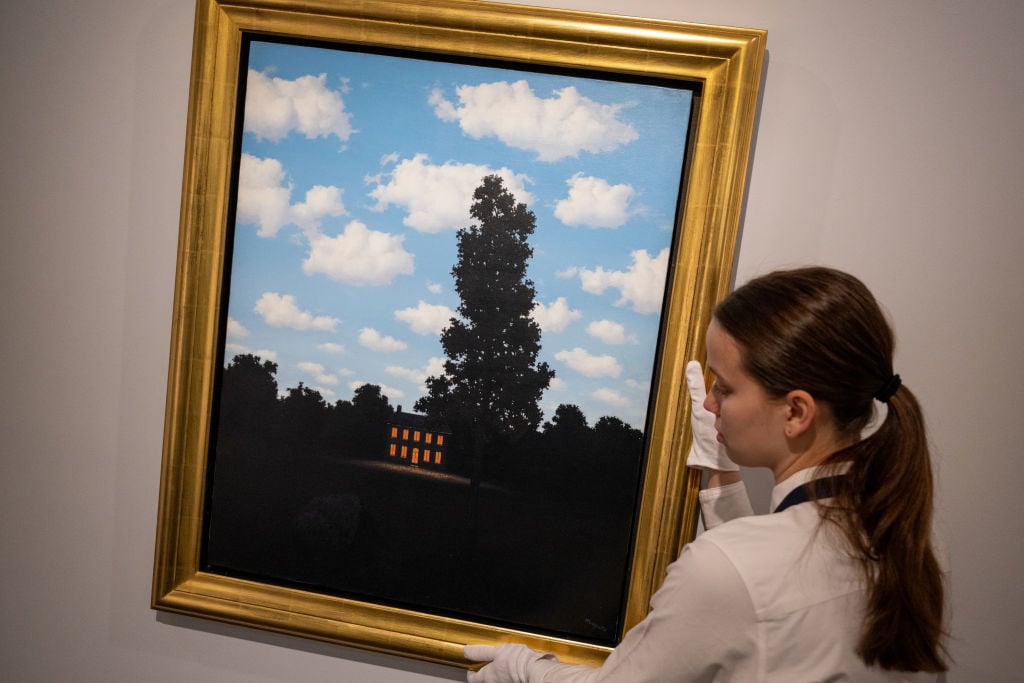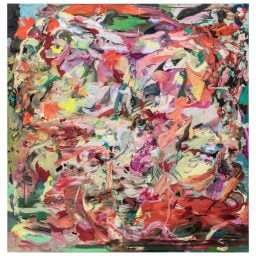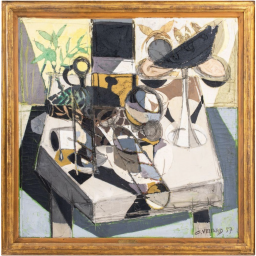It says a lot about the stratospheric heights that the art market has hit in previous seasons—last fall, the evening tally alone was $3.2 billion—that the combined presale estimates for the upcoming New York auctions feels like a bit of a let down.
Consider that the overall estimate for ten evening sales to be held over the next week is a cumulative $1.3 billion to $1.9 billion. A little over a decade ago, a $1 billion auction season seemed like a moonshot; now it has become commonplace.
Last fall, the comparable estimates were $2.1 billion to $2.9 billion, in no small part due to the many blockbuster offerings from the collection of late Microsoft co-founder Paul Allen. The eventual tally ballooned to over $3 billion, a result not likely to be repeated anytime soon.
For further context and comparison, evening sales in spring 2022 notched $2.4 billion, and the fall 2021 season came in at $2.3 billion. Last fall, 12 works were estimated to sell for more than $40 million each. This time around, a fraction of that—three works in total—carry that as a minimum. However, there is no shortage of works that have a minimum asking price over $20 million, which is still bonafide blue-chip territory.
And there is no shortage of top-flight private-collection offerings. Works from the collections of the late publishing magnate S.I. Newhouse and Boston real estate mogul Gerald Fineburg are on offer at Christie’s, while those of late American record executive Mo Ostin are for sale at Sotheby’s. The breadth and depth of these collections is stunning. The Newhouse collection, in particular, has some true jaw-droppers, despite this being the third tranche of his works to hit the auction block.
“S.I. Newhouse had a consistently discerning eye, and we see this over and over in the remarkable things that are sold from his collection,” art advisor Megan Fox Kelly said. “Gerald Fineberg collected deeply the artists he was committed to, and as you look through the collection, there is a certain bravado and exuberance that threads through the collection. Mo Austin is similarly distinguished in the discerning choices he made,” she added.
Of course, with the longstanding trend of increasing scarcity in outstanding Impressionist and Modern artworks—most have already been snapped up by institutions or private collectors—the material from single-owner collections, usually made available by the three Ds: debt, divorce, and death, is more important than ever.
“In the modern and postwar segments, it is all about the collections, the provenance, the estates—and the few iconic individual works like Picasso, Basquiat and Douanier Rousseau (works with a strong narrative, both in terms of the content and their history),” said Giovanna Bertazzoni, Christie’s vice-chairman of 20th- and 21st-century art.
Auction veteran turned private dealer David Norman echoed the category erosion narrative. “Dedicated Impressionist and Modern sales don’t really exist anymore,” he said. He estimates that up until a few years ago, excluding significant estate collections, the “various owners” sales were regularly around 60 lots, recalling, “We sometimes struggled to keep those numbers down”—excluding masterpieces from other genres such as postwar and contemporary, Latin American and American art, or even the occasional Old Master. Nowadays, the auction houses are more likely to include adjacent categories, such as works by female Surrealists.
There’s a particular dearth of Impressionist pieces at auction compared with 20 years ago, according to Norman. While those that are available “are very good,” he allowed, “at least for now, those old concerns about supply may be coming true.”
Not surprisingly, there is an increasing focus on contemporary art by all three major houses. Sotheby’s is leaning in to its smaller, powerful “The Now” ultra-contemporary sale. Launched in 2021, all three auctions held in New York so far have been 100 percent sold.
Particularly in the contemporary segment, “It’s about the proper capturing of the zeitgeist, especially in terms of gender parity,” Bertazzoni said. “We have plenty of great women artists, which is a wonderful achievement and a conscious endeavor.”
Here is a breakdown of the sales and the key lots to watch out for in the weeks ahead.
Willem de Kooning, Orestes (1947)
Estimate: in excess of $25 million
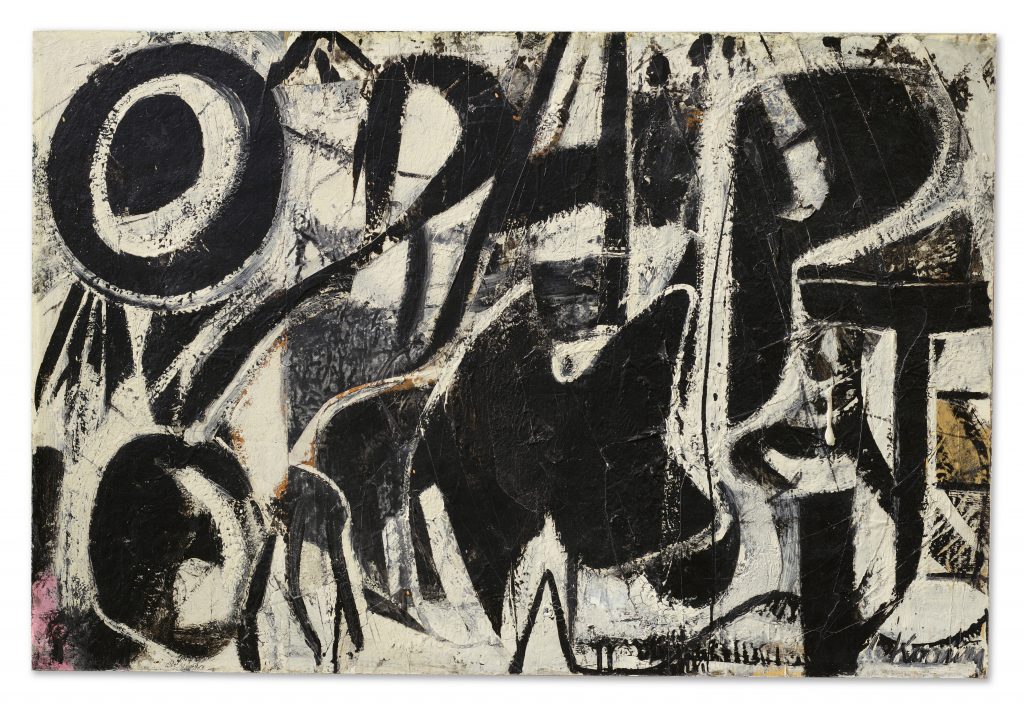
Willem de Kooning, Orestes (1947). Courtesy of Christie’s.
© 2023 The Willem de Kooning Foundation/Artists Rights Society, New York.
Sale: Masterpieces from the S.I. Newhouse Collection, Christie’s, May 11
Lots on offer: 16
Presale estimate: $142 to $202 million
Willem de Kooning’s Orestes (1947), an early black and white painting considered a pivotal work, as it was created at the dawn of the artist’s move into abstraction. It was included in his first solo exhibition at New York’s Charles Egan Gallery in 1948. Newhouse bought it at a 2002 Sotheby’s auction, for a premium-inclusive price of $13.2 million. The current estimate is in excess of $25 million.
Further sale highlights:
Other Newhouse collection highlights include Francis Bacon’s signature torqued visage, Self Portrait (1969), which depicts “bruised and blushed” features. The artist used a corduroy rag to print delicate, striated impressions across his mouth, nose, and shadowed eye sockets, according to the catalogue description. It is guaranteed by the auction house and carries an estimate of $22 million to $28 million. As always, repeat auction sales give a glimpse of just how far the market has come: According to the Artnet Price Database, the work was last sold at auction at Christie’s London in February 2006, where Newhouse acquired it. The price at the time was £5.2 million $9 million), far above the high presale estimate of £1.8 million.
Another highlight is PIcasso’s striking and colourful portrait, L’Arlésienne (Lee Miller), from 1937, which is estimated at $20 million to $30 million. It is one of seven portraits that the artist painted of Miller over the course of a 1937 trip that included “a heady summer spent in the south of France with a group of Surrealists.” Newhouse had owned it since 1999.
Pablo Picasso, Nature morte à la fenêtre (1932)
Estimate: in the region of $40 million
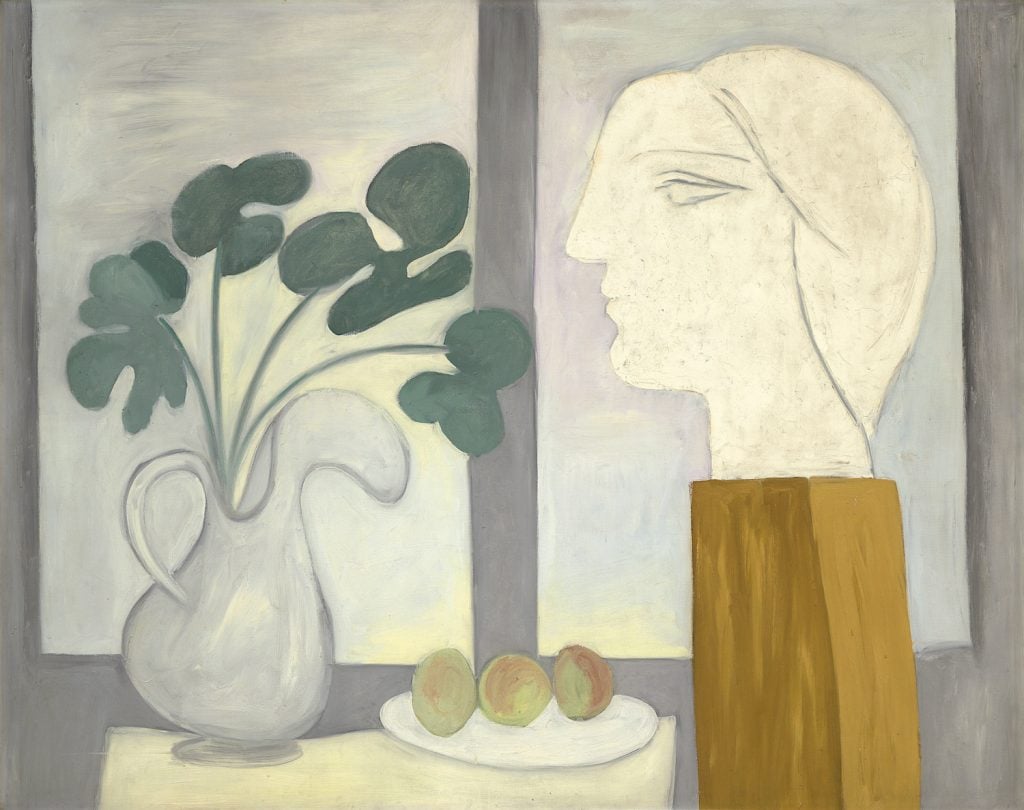
Pablo Picasso, Nature morte à la fenêtre (1932). Image courtesy Sotheby’s.
Sale: 20th-Century Art Evening Sale, Christie’s, May 11
Lots on offer: 57
Presale estimate: $260 million to $390 million
Pablo Picasso’s Nature morte à la fenêtre (1932). Picasso’s muse Marie-Thérèse Walter, who he met on the streets of Paris in the late 1920s and dove into a passionate affair with, inspired some his most famous works. The 1932 painting has an estimate in the region of $40 million. It looks back to the plaster busts that fascinated the artist over the course of 1931 and looks forward to the sensual nudes that he would paint later that spring. According to the catalogue, it’s a pivotal work within the story of Picasso’s “annus mirabilis.”
Further sale highlights:
Other highlights include one of market darling Ed Ruscha’s most famous works, Burning Gas Station (1966–69), estimated at $20 million to $30 million, offered from the Alana and Dorothy Press collection, and Henri Rousseau’s Les Flamants (1910), estimated at $20 million to $30 million. The latter is likely to reset the auction market, and fly past the current high-water mark of $4.4 million set in 1993, three decades ago.
Jean-Michel Basquiat, El Gran Espectaculo (1983)
Estimate: in the region of $45 million
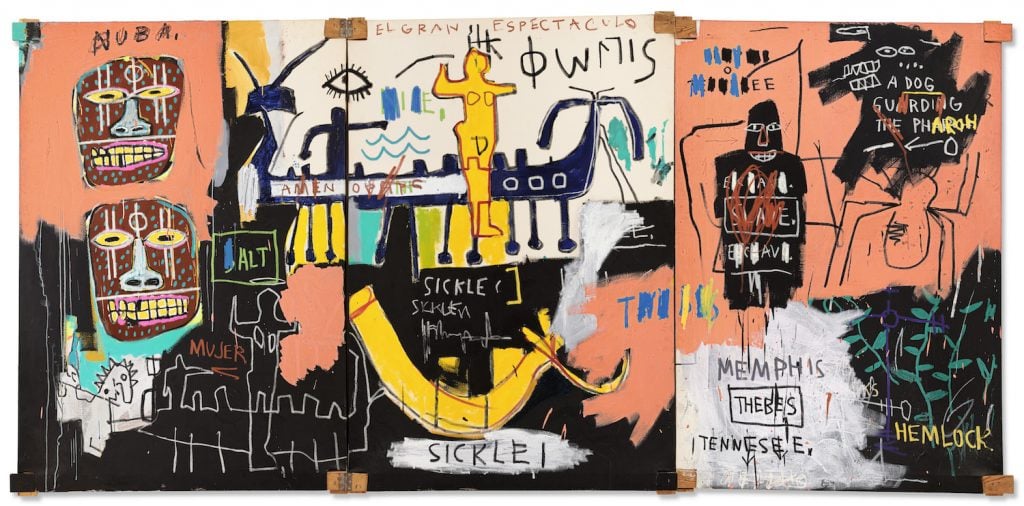
Jean-Michael Basquiat, El Gran Espectaculo (The Nile) (1983). Image courtesy Christie’s.
Sale: 21st-Century Art Evening Sale, Christie’s, May 15
Lots on offer: 27
Presale estimate: $68 million to $99 million
Jean-Michel Basquiat’s massive El Gran Espactaculo (1983) was painted when the artist was just 22 years old. It’s one of three large-scale canvases he executed that year; when he began to focus his painting on issues of representation in the context of world history. It last sold at auction for $5.2 million in November 2005. The current estimate on request is in the region of $45 million.
Further sale highlights:
Other highlights include a striking painting by Cecily Brown, currently the subject of an acclaimed retrospective at the Metropolitan Museum of Art. Untitled (The Beautiful and Damned) (2013) is estimated at $5 million to $7 million. As Artnet News Katya Kazakina reported on Friday, the consignor is Tony Pritzker, the billionaire scion of the family behind Hyatt Hotels. Meanwhile, Simone Leigh’s life-size bronze sculpture, Stick (2019), is expected to fetch between $2 million to $3 million.
René Magritte, L’Empire des lumières (1951)
Estimate: $35 million to $55 million
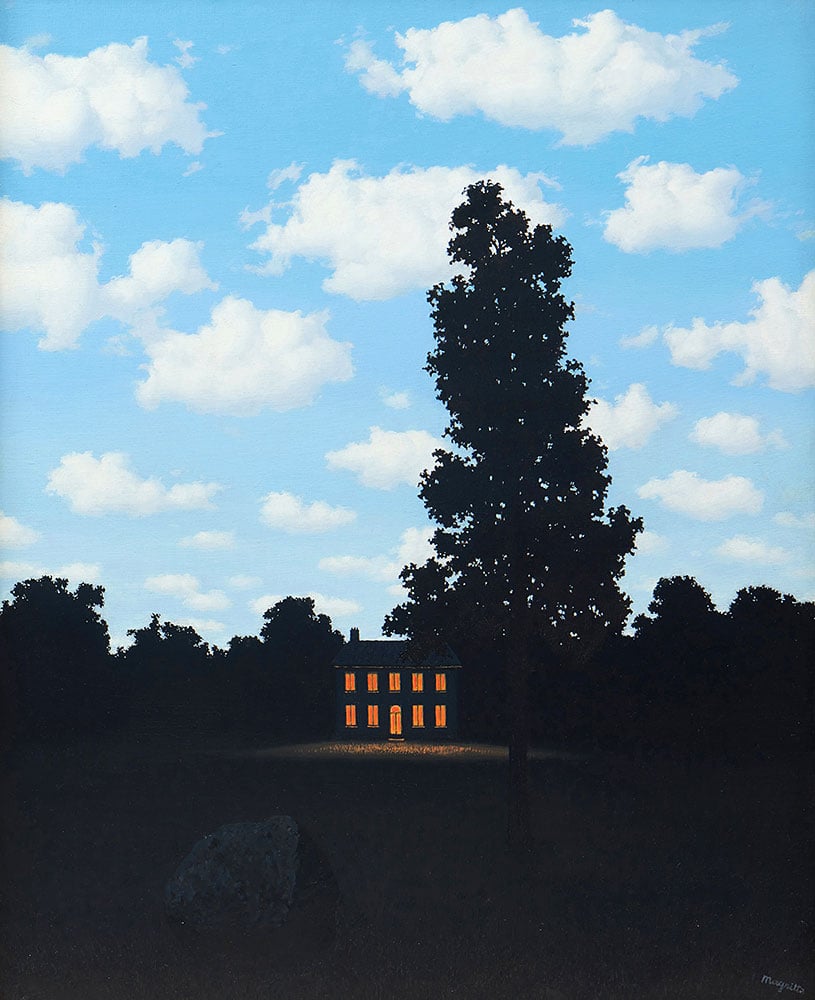
René Magritte, L’Empire des lumières (1951). Courtesy of Sotheby’s.
Sale: Mo Ostin Collection Evening Sale, Sotheby’s, May 16
Lots on offer: 15
Presale estimate: $103.3 million to $155.3 million
René Magritte’s L’Empire des lumières (1951), which is estimated at $35 million to $55 million, comes on the market just over a year after a new bar was set in the Magritte market last March, when L’Empire des lumières (1961) sold at Sotheby’s London for just under $80 million.
The latest example, which Sotheby’s Impressionist art specialist Julian Dawes called the “jewel of Ostin’s collection” is another top-flight work from the same series, and one Ostin owned for more than 40 years.
Sotheby’s called it “exceptionally crisp in its execution, focused in subject matter, and radiant in palette.” It was last seen in public at the Metropolitan Museum of Art in 1979. This is the first time it has ever been offered at auction.
Further sale highlights:
Yet another Magritte, Le Domaine d’Arnheim, (1949), a trippy scene of birds seen through a prism of shattered glass, takes its inspiration from the eponymous short story from 1850 by Edgar Allan Poe, a major source of inspiration for the artist. It carries an estimate of $15 million to $20 million. Look for other blue-chip trophies, such as an untitled work from 1962 by Cy Twombly, featuring the artist’s signature scribbles and dashes of bright pink paint (estimated at $14 million to $18 million), and a circa 1958 Joan Mitchell, Untitled, with a price tag of $7 million to $10 million. Noting that Ostin, who began collecting in the 1970s acquired many of these works before the respective artists’ markets were firmly established, Dawes praised the collector’s “estoteric, bold choices.”
Gustav Klimt, Insel im Attersee (Island in the Attersee) (c. 1901–2)
Estimate: in the region of $45 million
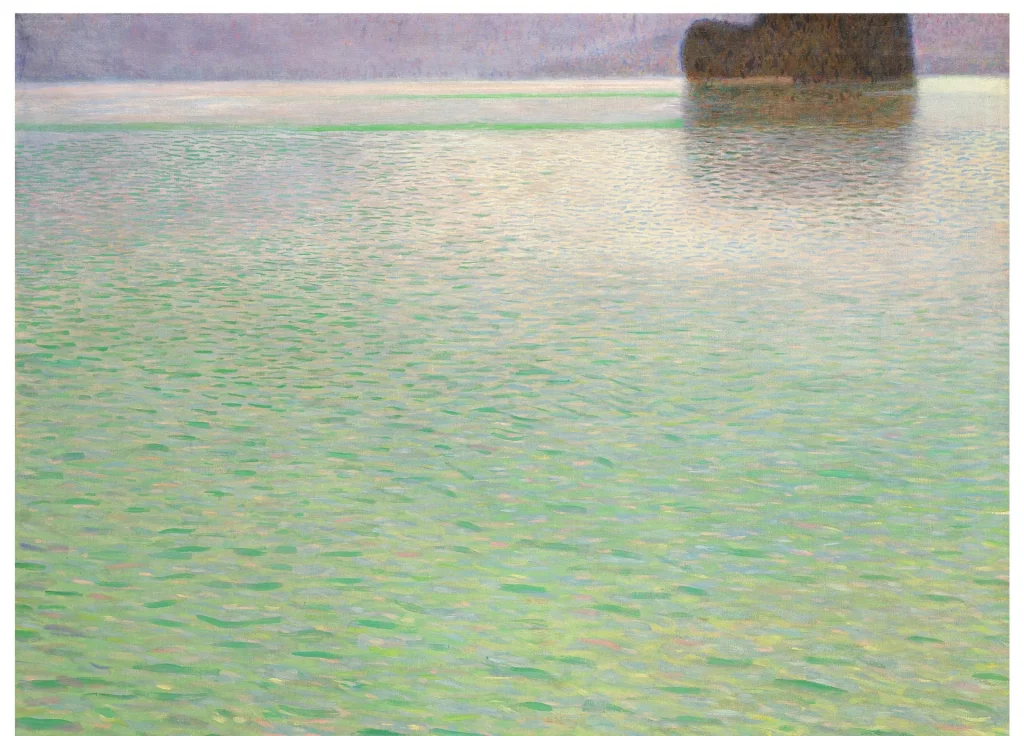
Gustav Klimt, Insel im Attersee (1901-02). Courtesy of Sotheby’s.
Sale: Modern Evening Auction, Sotheby’s, May 16
Lots on offer: 54
Presale estimate: $290.6 million to $404.7 million
Gustav Klimt’s Insel im Attersee (Island in the Attersee) (circa 1901–2) is a rare seascape by the artist, and estimated in the region of $45 million. “It was his summer vacation spot,” said Allegra Bettini, vice president and head of Sotheby’s modern evening sale, during a recent walkthrough. “It was where Klimt escaped his studio in Vienna…and was able to choose what he wanted to paint….It’s almost more of a poem to nature than it is an exacting landscape depiction. The brushwork is incredibly free, but also contains that thoughtful approach that you see in the majority of his work.” The painting, which is backed by a third party, or irrevocable bid, has never been offered at auction before.
Further sale highlights:
An unusual highlight of the modern sale this time, afforded by the more fluid categories introduced at all the auction houses, is Sir Peter Paul Rubens’s Baroque work, Portrait of a Man as the God Mars (circa 1620), with an estimate of $20 million to $30 million.
Sotheby’s is also offering four works from the collection of legendary dealer Ambrose Vollard, including a stunning 1885 Gauguin floral still life (est. $10 million—$15 million), a Renoir seascape circa 1884 (est. $1 million–$1.5 million), a red chalk by Renoir depicting the judgment of Paris (est: $300,000–$500,000), and a watercolor and pencil work on paper by Paul Cézanne, Sous-bois (circa 1882–4), that is estimated at $250,000 to $350,000.
The Codex Sassoon
Estimate: $30 million to $50 million
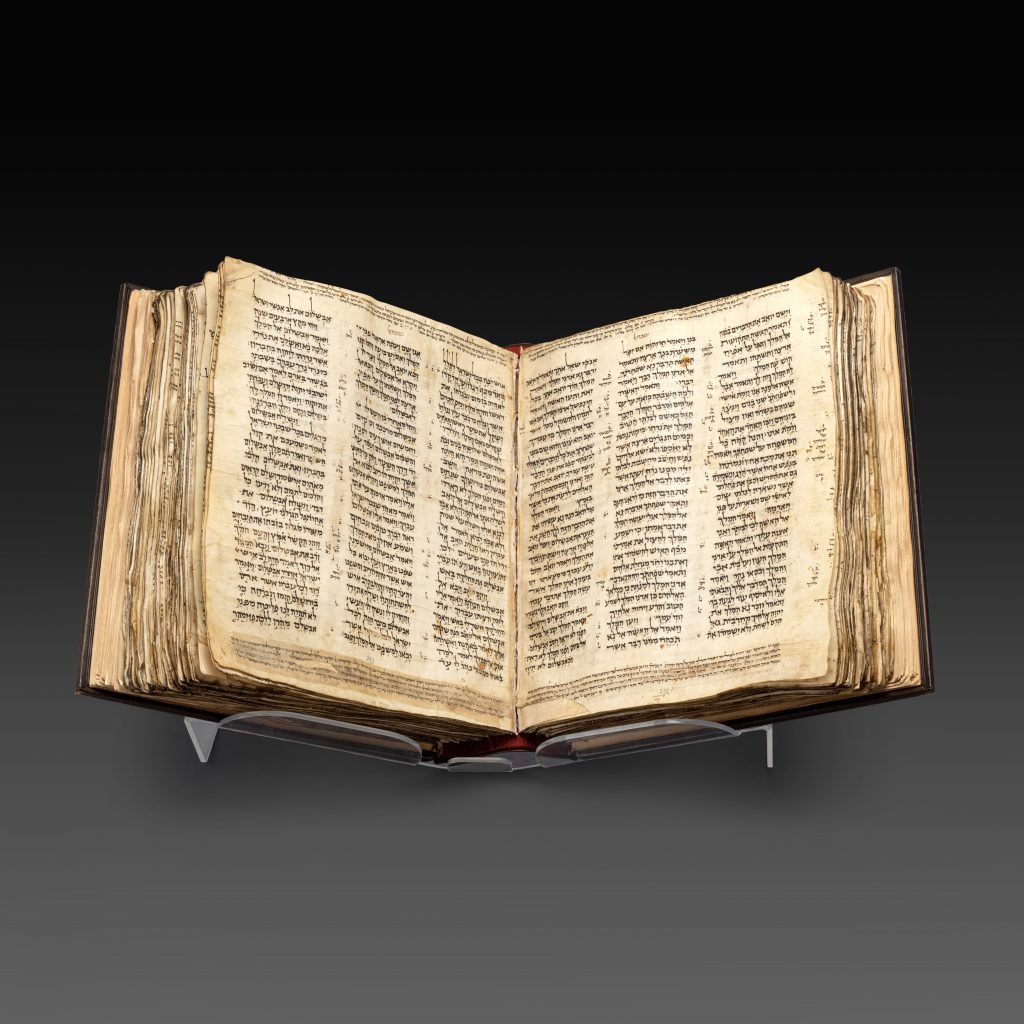
The Codex Sassoon. Photo courtesy of Sotheby’s.
Sale: Codex Sassoon: The Earliest Most Complete Hebrew Bible, Sotheby’s, May 17
Lots on offer: 1
Sale Estimate: $30 million to $50 million
Coming to auction for the first time in more than three decades, the Codex Sassoon—named for its modern owner, David Solomon Sassoon—is the most valuable printed book, manuscript, or historical document by estimate ever offered at auction. “The Hebrew Bible is the sacred, foundational text for peoples across the globe,” said Sharon Mintz, Sotheby’s senior specialist for Judaica, books, and manuscripts. “Codex Sassoon marks a critical turning point in how we perceive the history of the divine word across thousands of years.”
Pablo Picasso, Tête de femme au chignon
Estimate: $6 million to $9 million
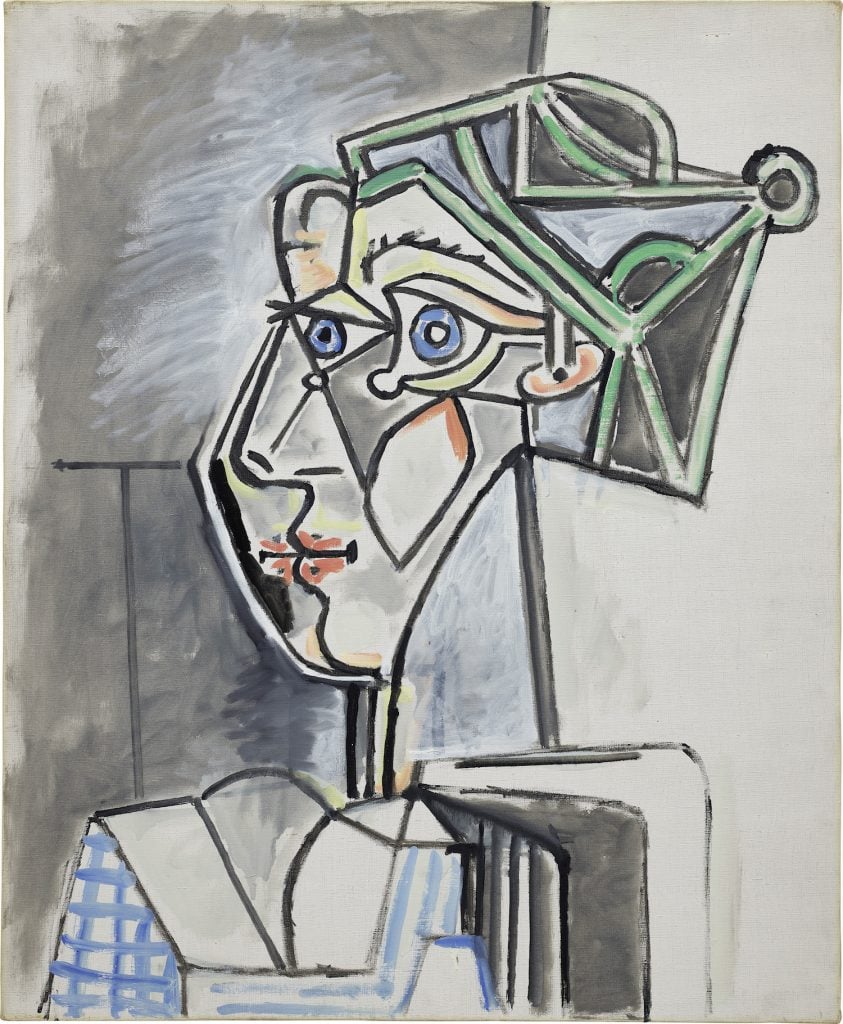
Pablo Picasso, Tête de femme au chignon (1952). Image courtesy Phillips.
Sale: 20th-Century Art and Contemporary Evening Sale, Phillips, May 17
Lots on offer: 41
Sale Estimate: $63.5 million to $91.4 million
Pictured above is the second most expensive lot of the sale, Picasso’s Tête de femme au chignon (est. $6 million–$9 million), painted in 1952, the final year of his pivotal relationship with the artist Françoise Gilot. Facing to the left, she sits with her hair pulled back, gazing out a window marked by black bars.
Further sale highlights:
Banksy’s Banksquiat. Boy and Dog in Stop and Search (2018) is the most expensive lot of the sale, with an estimate of $8 million to $12 million. The work, executed on panel, features two figures from Basquiat’s 1982 painting Boy and Dog in a Johnnypump being frisked by members of London’s Metropolitan Police. Basquiat’s boy and dog are rendered in the artist’s gestural, painterly style, while the police officers are executed using Banksy’s signature black-and-white stencil technique. Other highlights include two early Yayoi Kusama soft sculpture works from the collection of Agnes and Frits Becht. Red Stripes (1965) and Blue Spots (1965) are estimated at $2.5 million to $3.5 million apiece. Other highlights include paintings by Ewa Juskewicz, Yoshitomo Nara, Ed Ruscha, and Henry Taylor.
Christopher Wool, Untitled (1993)
Estimate: $15 million to $20 million
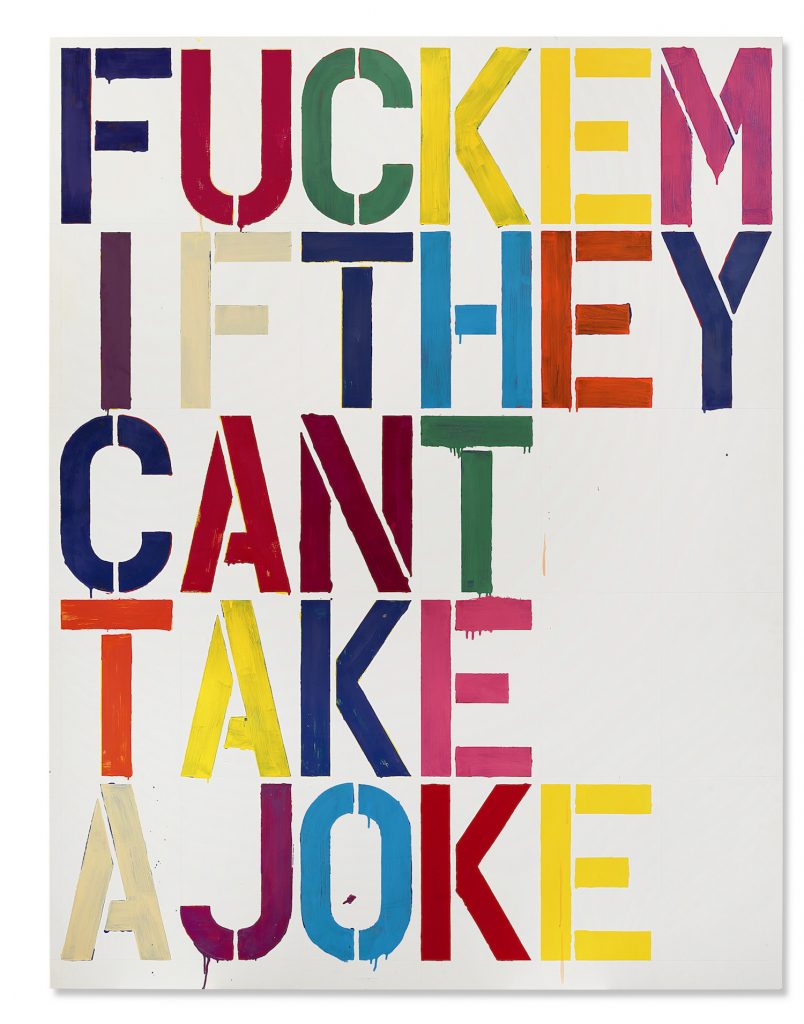
Christopher Wool, Untitled (1993). Courtesy of Christie’s.
Sale: A Century of Art: The Gerald Fineberg Collection Part I, Christie’s, May 17
Lots on offer: 65
Presale estimate: $163 million to $235 million
Christopher Wool, Untitled (1993), is an exceedingly rare multicolored example of one of his word paintings. It reads “Fuck ’em If They Can’t Take a Joke.” It’s one of several highlights of the Fineberg evening collection and one of two works estimated at $15 million to $20 million. Fineberg bought it soon after it was painted, in 1994, and had owned it ever since.
Further sale highlights:
The other top lot, with an identical estimate, is Gerhard Richter’s Badende (1967), from the artist’s early series of female nudes. A swirling Untitled abstract painting (1956–59) by Lee Krasner, meanwhile, is estimated at $6 million to $8 million. And Barkley Hendricks’s full-length portrait of the artist Stanley Whitney, Stanley (1971), is sure to spark heated competition. The estimate is $5 million to $7 million.
Yoshitomo Nara, Haze Days (1998)
Estimate: $12 million to $18 million

Yoshitomo Nara, Haze Days (1998). Courtesy of Sotheby’s.
Sale: The Now Evening Sale, Sotheby’s, May 18
Lots on offer: 25
Presale estimate: $42.4 million to $61.9 million
One of Japanese art star Yoshitomo Nara’s signature cartoon girls with a huge head and a menacing stare leads this sale of ultra-contemporary art. The work is estimated at $12 million to $18 million. The record for a Nara work at auction is just under $25 million. The bandage and glaring eyes suggest the character has just sustained some type of injury or tumble, as Sotheby’s contemporary art specialist Lucius Elliot noted during a tour of the sale highlights, possibly an “overt nod” to Van Gogh’s Self-Portrait with bandaged ear. Given the intense international demand for Nara, expect sparks to fly.
Further sale highlights:
Other top lots in the sale include paintings by Kerry James Marshall, Mark Grotjahn, and Mark Bradford, and a major sculpture by Simone Leigh.
Louise Bourgeois Spider (1996)
Estimate: $30 million to $40 million
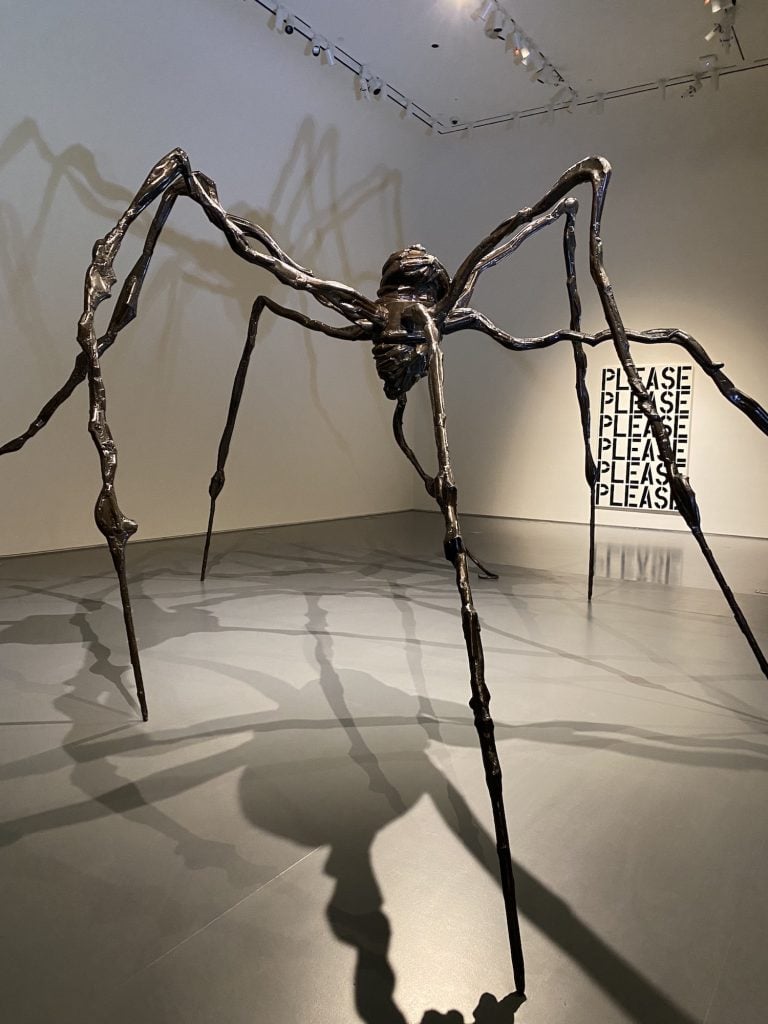
Installation view of Louise Bourgeois Spider (1996) at Sotheby’s. Photo by Eileen Kinsella
Sale: Contemporary Evening Sale, Sotheby’s, May 18
Lots on Offer: 32
Presale estimate: $154.9 million to $209.8 million
Appropriately described as “at once beautiful and haunting, familiar and uncanny” by Sotheby’s, the first cast of Louise Bourgeois’s intriguing large-scale spider carries a hefty estimate of $30 million to $40 million. The seller is the nonprofit arm of a Brazilian bank. It’s the highest-ever estimate placed on a work for auction by the artist, and among the most valuable ever to appear at auction by a woman artist.
Further sale highlights:
Another highlight with a similar estimate in excess of $30 million is a rare, large circle-shaped painting by Jean-Michel Basquiat, shaped like a vinyl record, Now’s The Time (1985). A nod to Charlie Parker, the piece was consigned by media magnate Peter Brant. Sotheby’s calls it “a monumental ode to jazz” and one of the artist’s most singular and important works. Another star lot is a “color chart” painting by Gerhard Richter, 4096 Farben (1974), which is estimated at $18 million to $25 million.
